SAF1000 User Guide: Difference between revisions
No edit summary |
No edit summary |
||
| Line 30: | Line 30: | ||
{{UgVoltageInputSupply|SAF1000}} | {{UgVoltageInputSupply|SAF1000}} | ||
{{ugAddressingInformation}} | |||
===Using Your Own Program=== | |||
You are now ready to start writing your own code for the device. The best way to do that is to start from our examples: | |||
This Phidget is compatible with the {{ExampleLink|PowerGuard}}, the {{ExampleLink|VoltageInput}}, and the {{ExampleLink|TemperatureSensor}}. | |||
Once you have your example, you will need to follow the instructions on the page for your programming language to get it running. To find these instructions, select your programming language from the [[Software_Overview#Language_Support|Software Overview]] page. | |||
{{UGnext|}} | {{UGnext|}} | ||
Revision as of 19:46, 27 August 2018
Getting Started
Welcome to the SAF1000 user guide! In order to get started, make sure you have the following hardware on hand:
- SAF1000 Programmable Power Guard Phidget
- VINT Hub
- Power supply
- Phidget cable
- USB cable and computer
Next, you will need to connect the pieces:
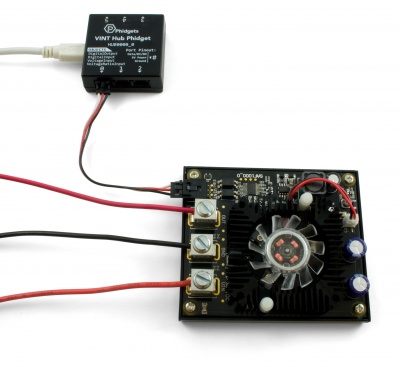
- Connect the SAF1000 to your VINT Hub using the Phidget cable.
- Connect the VINT Hub to your computer using the USB cable.
- Connect the positive power terminal of the device you're powering to the "OUT" terminal on the SAF1000.
- Connect the ground terminal of the device you're powering to the ground terminal on the SAF1000.
- Connect the positive and negative wires of your power supply to the "Vin" and "GND" terminals of the SAF1000, respectively.
- Plug in your power supply.
Using the SAF1000
Phidget Control Panel
In order to demonstrate the functionality of the SAF1000, the Phidget Control Panel running on a Windows machine will be used.
The Phidget Control Panel is available for use on both macOS and Windows machines.
Windows
To open the Phidget Control Panel on Windows, find the ![]() icon in the taskbar. If it is not there, open up the start menu and search for Phidget Control Panel
icon in the taskbar. If it is not there, open up the start menu and search for Phidget Control Panel
macOS
To open the Phidget Control Panel on macOS, open Finder and navigate to the Phidget Control Panel in the Applications list. Double click on the ![]() icon to bring up the Phidget Control Panel.
icon to bring up the Phidget Control Panel.
For more information, take a look at the getting started guide for your operating system:
Linux users can follow the getting started with Linux guide and continue reading here for more information about the SAF1000.
First Look
After plugging the SAF1000 into your computer and opening the Phidget Control Panel, you will see something like this:
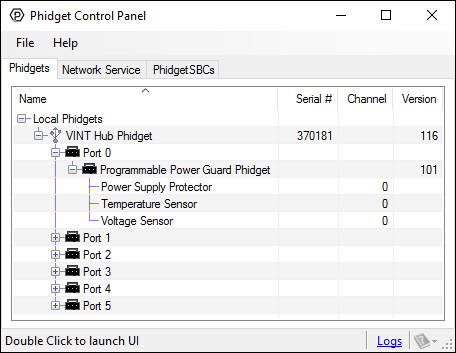
The Phidget Control Panel will list all connected Phidgets and associated objects, as well as the following information:
- Serial number: allows you to differentiate between similar Phidgets.
- Channel: allows you to differentiate between similar objects on a Phidget.
- Version number: corresponds to the firmware version your Phidget is running. If your Phidget is listed in red, your firmware is out of date. Update the firmware by double-clicking the entry.
The Phidget Control Panel can also be used to test your device. Double-clicking on an object will open an example.
Power Supply Protector
Double click on the Power Supply Protector object in order to run the example:
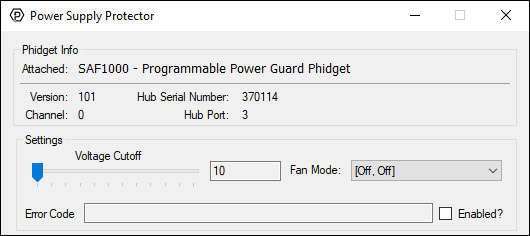
General information about the selected object will be displayed at the top of the window. You can also experiment with the following functionality:
- Adjust the voltage cutoff slider to determine at which voltage the SAF1000 will cut power to your system.
- Select the fan mode- on, off, or auto (automatically turns on when board reaches 70°C, turns off after dropping below 55°C)
- Click the enabled box once the cutoff and fan mode are set in order to activate the SAF1000.
Temperature Sensor
Double-click on the Temperature Sensor object , labelled Temperature Sensor, in order to run the example:
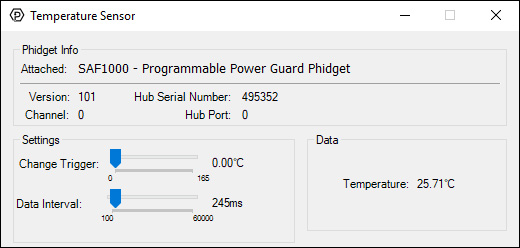
General information about the selected object will be displayed at the top of the window. You can also experiment with the following functionality:
- Modify the change trigger and/or data interval value by dragging the sliders. For more information on these settings, see the data interval/change trigger page.
- The measured temperature can be seen next to the Temperature label. Cover the board with your hands to see the temperature quickly rise.
Supply Voltage Input
Double-click on a Supply Voltage Input object in order to run the example:
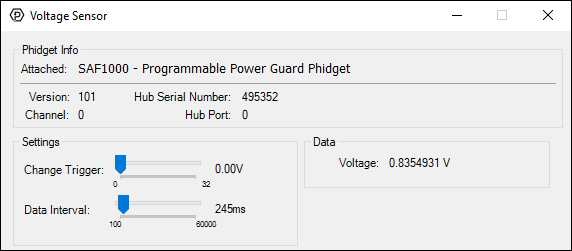
General information about the selected object will be displayed at the top of the window. You can also experiment with the following functionality:
- At the top of the window, information about your device and the properties of this particular channel will be listed.
- On the left, change trigger and/or data interval can be changed. For more information on these settings, see the Data Rate/Change Trigger page.
- On the right, the supply voltage of the Phidget is displayed in real-time.
Finding The Addressing Information
Before you can access the device in your own code, and from our examples, you'll need to take note of the addressing parameters for your Phidget. These will indicate how the Phidget is physically connected to your application. For simplicity, these parameters can be found by clicking the button at the top of the Control Panel example for that Phidget.

In the Addressing Information window, the section above the line displays information you will need to connect to your Phidget from any application. In particular, note the Channel Class field as this will be the API you will need to use with your Phidget, and the type of example you should use to get started with it. The section below the line provides information about the network the Phidget is connected on if it is attached remotely. Keep track of these parameters moving forward, as you will need them once you start running our examples or your own code.

Using Your Own Program
You are now ready to start writing your own code for the device. The best way to do that is to start from our examples:
This Phidget is compatible with the PowerGuard Examples, the VoltageInput Examples, and the TemperatureSensor Examples.
Once you have your example, you will need to follow the instructions on the page for your programming language to get it running. To find these instructions, select your programming language from the Software Overview page.
What to do Next
- Programming Languages - Find your preferred programming language here and learn how to write your own code with Phidgets!
- Phidget Programming Basics - Once you have set up Phidgets to work with your programming environment, we recommend you read our page on to learn the fundamentals of programming with Phidgets.
